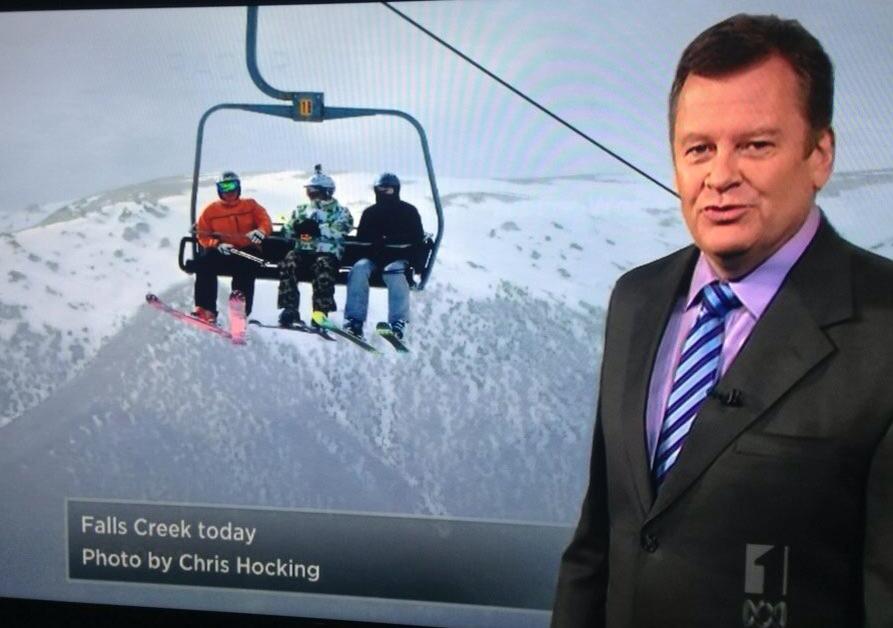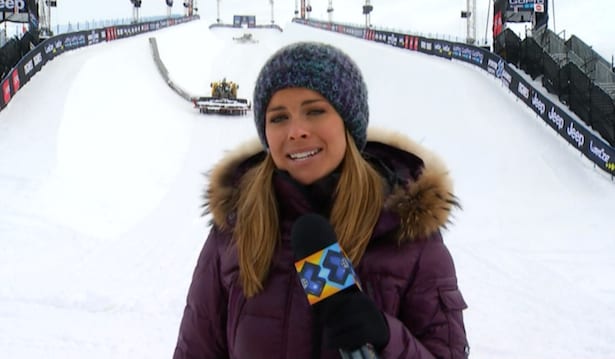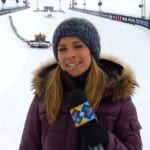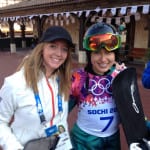Fancy a life in front of the camera, behind the camera or forecasting snow online? Yvette Maurice talks to three of Australia’s best.
You hear them on the radio, follow them on social media and watch their forecasts on TV – but have you ever wondered what it takes to be a great snow reporter?
Often the realities of the job can be quite harsh, 5.00 am starts, frozen camera equipment and cold fingers and toes – all to keep your audience in the know when it comes to the conditions they can expect at the snowfields.
“In a typical day when I was snow reporting I might voice a radio report, present a television piece, write a media release, update social media and interview the winner of a big event,” says Thredbo Communications Manager Susie Diver who has accumulated twenty years in the snow business.
“No two days have ever been the same; it has been and will always be a fast-paced and deadline driven world.”
“Expect early starts,” warns Chris Hocking, onsite cameraman and photographer at Falls Creek in Victoria. Hocking films and edits the reports, shoots stills and distributes both to media around the country.
“You’ve got to be able to get to all vantage points on the mountain, so having skiing and boarding skills are important, not just for access, but also for credibility.”

Snow reporting is serious business. Last season, Diver completed over eleven hundred radio snow reports, hundreds of television snow reports, Twitter and Facebook and Instagram daily updates, countless website updates, as well as lots of live crosses for TV and radio.
Peter Taylor of Thirroul, New South Wales is the owner and head snow forecaster of online snow forecasting website Snowatch. A veteran print forecaster since 1997, Taylor now reports online and says “A good snow forecast reporter is someone who is honest and concise.”
It’s a given that authenticity and a strong understanding of the conditions are important more so in an instant new media world. According to Diver, there are other skills a great snow reporter needs to have.
“Be outgoing and energetic as well as a quick thinker with solid writing skills.” She also suggests that those looking to get into snow reporting need to have great personalities and be, “creative, professional but fun.”
Snow reporting has traditionally been a stepping stone to bigger media careers and a great way to gain career miles and valuable experience at both live and pre recorded television and radio. Many snow reporters have gone on to other plum roles in the media, or even further.
Scott Mackinnon started as a Thredbo reporter and became a sports reporter at Network TEN. Ramona Bruland filed reports for Falls Creek and now hosts the X-Games for ESPN.
- Ramona Bruland was ‘discovered’ in Falls Creek
- 2GB Deputy News Director Natalie Peters was a snow reporter at Perisher
- Sky News anchor Jacinta Tynan, former Thredbo snow reporter
- Laura Jayes on Sky started her career as a snow reporter
- Scott McKinnan is TEN’s sports guru but he was once a reporter for Thredbo
- X Games Host Ramona Bruland was a Falls Creek snow reporter
The Deputy News Director of 2GB, Nat Peters, started her career as a snow reporter at Perisher, Sky News Anchor Jacinta Tynan began hers in Thredbo and Sky News Political Reporter Laura Jayes did the hard yards at Hotham.
“Some reporters have used it as a stepping stone to lifestyle television for sports reporting,” Hocking explains.
“Once you’ve got your face on TV and compiled a show reel, you can use your industry contacts to progress.”
Diver agrees. “It is a great way to sample all kinds of media,” the Communications Manager says. “After four months on the job, (snow reporters) finish the season with a cache of new skills and experience.”
Be prepared to think on your feet as like all things ‘live’ anything can happen. Power failures back at the office can affect broadcast connections, weather on the mountains is also tough on the camera gear and electrics.
“Broadcast cameras can shut down in the cold and snow,” Hocking says. “You need a backup plan or a second camera just in case.”
“Beware of condensation too; never bring a cold camera back into a warm room. It’ll fog the lens and shut down your camera for the day.”
Diver has had a more unique problem. “Buy water-proof mascara,” she says, and hone your boarding or skiing skills.
But there is one thing that makes a good snow report in Taylor’s opinion. “Be honest and people will respect you for it. A good report is always an honest one.”
Taylor suggests that everyday snow-goers can learn some of the skills needed to become a snow forecaster themselves. He recommends fine-tuning your ‘forecasting formula’ over time to become more consistent.
“Why not have a go at publishing your own predictions?” he says. “Many Facebook and Twitter forecasting sites are now more reliant on posts from casual forecasters.”
Most ski resorts employ snow reporters on-site every season and the gigs are well sought after so make contact as early as you can.
“Over the years in Thredbo I have enjoyed working with each and every snow reporter at the fields,” says Diver. “They all have their highlights.”
Hocking is also really clear about why he loves the gig so much. “Sharing the passion I have for the snow means a lot to me,” he says.
“Everyone’s up to have a good time at the snow. Relax and enjoy the winter vibe, don’t sweat the small stuff.”
Follow SnowsBest & @misssnowitall on Facebook, Twitter and Instagram.
Yvette Maurice loves media. As a blogger, writer and journalist she has produced media for some of Australia’s best including 2Day FM, 2GB, Crikey and Fairfax and now, SnowsBest.













I follow snowatch during winter, I also keep an eye on Chris Hocking and Jane Bunn.
And lets not forget weather man, Gary Youngberry at Nine in Brisbane, started as a snow reporter at Perisher